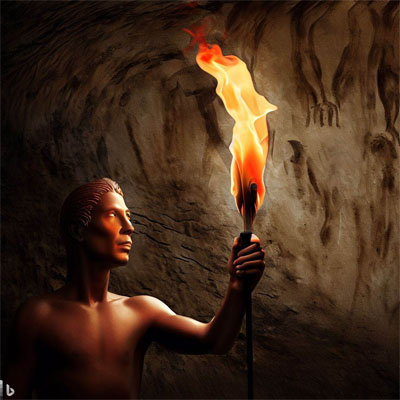Introduction:
Ancient cave paintings, the most archaic expressions of human creativity, provide a window into the spiritual practices and beliefs of our ancestors. These early art forms offer profound insights into the evolution of human consciousness, showcasing the primal efforts to understand and articulate the human place within the cosmos. Often attributed to hunter-gatherer societies, these depictions unearth an intricate relationship between humans and their environment, weaving narratives of survival, spirituality, and symbolism.
Roots of Spiritual Expression:
The labyrinthine recesses of ancient caves like Lascaux, Chauvet, and Altamira offer a trove of artistry that transport us back to the dawn of human cognition. Among the first artists, Paleolithic humans used the cave walls as their canvas to interpret their encounters with the mystical, the unexplained, and the celestial. Whether etched, painted, or drawn with charcoal, ochre, and other pigments, the images formed complex symbols representing an early spiritual symbiosis between humans and nature.
The subjects of these cave paintings often included animals like horses, bison, deer, and mammoths. They were rendered with a realism that suggests a deep respect and reverence for these creatures. This intense focus on wildlife likely symbolizes the dependence of early humans on the natural world for sustenance and survival. But it may also indicate an early form of animism, where all objects, places, and creatures possess a distinct spiritual essence. Through these depictions, the artists may have been attempting to connect with the spirit of the animals, invoking their power and protection, an element of the hunt that was as spiritual as it was pragmatic.
Metaphysical Journeys:
More than simply illustrating their physical surroundings, ancient cave paintings may also have been used to portray metaphysical journeys. The spiritual concepts of life, death, and the afterlife were likely central themes within the societal structures of these early humans, and these art forms served as conduits to express these notions.
The geometric patterns, dots, and lines frequently found in these cave paintings often perplex modern observers due to their abstract nature. However, these symbols could have served as spiritual or metaphysical maps, guiding the artist and viewer through various stages of a spiritual journey, or perhaps representing different realms of existence. They could also denote rituals, celestial bodies, or other aspects of their spiritual universe, transcending the physical world and embodying a deeper understanding of existence.
Rites and Rituals:
The often remote and inaccessible location of many ancient cave paintings suggest that these were not casual or merely decorative artworks, but rather sites of profound importance. Some anthropologists and archeologists speculate that these caves served as sacred places for spiritual ceremonies and rituals. These rituals may have ranged from initiation ceremonies, to shamanistic practices, to seasonal ceremonies aligned with celestial movements.
The presence of handprints is a recurring theme in many of these ancient art sites, such as in Argentina’s Cueva de las Manos. Often, these are negative handprints, created by blowing pigment around a hand placed on the wall. This personal, human mark within the cave’s spiritual art can be interpreted as a deep desire for connection, a tangible bond between the physical and the spiritual world, or even as a spiritual signature or blessing.
A Reflection of Consciousness:
Cave paintings can also be seen as a reflection of the evolving human consciousness. The act of painting required the artist to project their inner thoughts and feelings onto the cave wall, a feat requiring abstract thinking and self-awareness. This could be seen as evidence of an awakening self-consciousness and an increasing sense of individuality and introspection.
The spiritual qualities of these cave paintings offer a striking demonstration of our ancestors’ cognitive abilities. They reveal early humans’ capacity to perceive and interpret their experiences, to symbolize and express thoughts, and to communicate complex ideas about their spiritual universe.
Conclusion:
In the silent depths of ancient caves, our ancestors used art as a spiritual language, bridging the gap between the tangible world and the mystical realm. Ancient cave paintings, thus, are not mere prehistoric artifacts; they are testament to humanity’s timeless quest for spiritual understanding and connection. The mysteries they hold, the stories they tell, and the spirituality they embody remain as potent and captivating now as they were tens of thousands of years ago, truly timeless expressions of the human spirit.
Hits: 42

